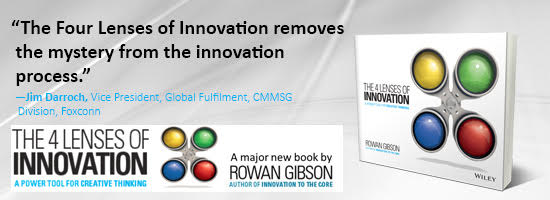Innovating for a Worse Customer Experience (Insights from United Airlines)
 I believe most innovators typically think of their work as somewhat noble. Innovation drive progress that is typically in service of the customers and consumers we serve. In big or small ways, our goals usually involve making people’s lives better, easier, and more enjoyable. But what happens when we are asked to do the opposite?
I believe most innovators typically think of their work as somewhat noble. Innovation drive progress that is typically in service of the customers and consumers we serve. In big or small ways, our goals usually involve making people’s lives better, easier, and more enjoyable. But what happens when we are asked to do the opposite?
The Dark Side of Innovation
This week’s debacle at United Airlines highlighted a darker side of Innovation. While this was an extreme example of terrible customer service, I think it is merely the tip of the commercial innovation ‘iceberg’ that has been pervasive in the airline industry for many years. Charging for hold baggage, ticket changes and seat reservations, overbooking and reduced seat size and legroom are all ‘commercial innovations’, but this innovation is targeted almost exclusively at the bottom line. And this is a trend that is far from finished. For example, this year United started charging for carry-on baggage on its ‘basic’ fare tickets, and at least until this week, it was hard to imagine that other airlines would not follow.
Slicing the Salami
To be fair to United, they are not alone. “Slicing the salami†is common in all sorts of industries, as companies look for creative, innovative ways to squeeze out costs and boost profits. It is quite common in product innovation, where ingredients or quantities are reduced in ways that aim to cut costs without noticeably impacting performance. And there are many examples in commercial innovation that stretch well beyond the airline industry. For example, in my adopted hometown of Las Vegas, free parking has long been a ‘sacred cow’ benefit designed to draw people into casinos. However, last year, MGM started charging a substantial sum for parking and followed it up with a further substantial increase announced just a week ago. As with the airlines, other casino companies are starting to follow, albeit carefully. We can all probably think of examples from banks, cable companies, concert tickets, etc. Of course, there is usually an attempt to justify these moves, whether they are framed as convenience charges, or as in the case of casino parking, reframed as providing ‘better facilities’. But in reality, it is hard to see this as anything other than innovation in service of the bottom line, and to varying degrees at the expense of customers.
Brand Authenticity
This raises two somewhat distinct challenges. The first lies in how these attempts to reframe these commercial innovations as benefits impacts a brand’s authenticity. I still recall my bank in Cincinnati posting a note on its door that proudly proclaimed that ‘To serve you better, this branch will now be closed on Saturdaysâ€. I cannot imagine anyone really bought into that, any more than to “convenience charges†or paying to use overhead airplane lockers. My question is whether, in the long run, this reframing does even more damage than the cost cutting itself.  While I haven’t seen data, I have to believe a straightforward “to keep cost and price down, we are now charging you for…†would be far better for brand authenticity than attempts to spin reduction of service as a benefit. Likewise, nickel and diming is a dangerous path to take, as eventually, it will drive people away. We know that people are poor at predicting their own future behaviors, and so it is unlikely that conventional research will accurately predict long-term changes in demand that may result from these ‘commercial innovations’. Without test markets in realistic contexts, there is a real danger of discovering long term consequences only after effects have taken hold, and are difficult or impossible to correct. Taking airlines as an example, I’ve personally noticed a lot of positive free publicity for both SouthWest and Virgin Atlantic this week, as people compare them positively to United on social media, and in ways that I suspect reflect long-term equity differences associated with different approaches to commercial innovation and customer service.
Job Satisfaction and Retention
The second is the impact on recruitment and retention of innovators. People who get into innovation tend to like to work on big ideas that benefit the customer. Anecdotally, I’ve never seen an innovator get terribly excited about being assigned a cost-cutting role. To be fair, I’ve had to work on my fair share of cost cutting projects over the years, and most people will accept a little salami slicing and optimization from time to time as an unavoidable part of the job. But when a culture shifts towards cost cutting as a higher priority than benefit driven innovation, I suspect it is a different matter. What company is going to attract the best innovators; one where they can work on big, breakthrough, disruptive innovations that people love, or one focused on cost cutting and salami slicing?
Of course, the ideal of innovation is always better and cheaper – that is what most innovators strive for. But in reality, it is not always possible. Furthermore, there are some situations where slicing the salami may actually deliver benefits. Reducing serving size in restaurants or the snack food industry may well deliver health benefits to consumers, and with jumbo sized servings, there may be zero downside to the customer, either real or perceived.
A Different Innovators Dilemma
But in general, innovating to provide less, whether it is performance, value or quantity, is not what most of us signed up for, and while it can have short-term benefits, often comes with hard to quantify downsides for the company as well.
So how do you feel when you are asked to slice the salami or to engage in commercial innovation that reduces the value of the product of service that you innovate for? And when is enough enough, and the salami slices become big enough chunks that they do real damage to a brand? These are some different, but real Innovators Dilemmas.
image credit: money.cnn.com

Wait! Before you go…
Choose how you want the latest innovation content delivered to you:
- Daily — RSS Feed — Email — Twitter — Facebook — Linkedin Today
- Weekly — Email Newsletter — Free Magazine — Linkedin Group
 A twenty-five year Procter & Gamble veteran, Pete Foley has spent the last 8+ years applying insights from psychology and behavioral science to innovation, product design, and brand communication. He spent 17 years as a serial innovator, creating novel products, perfume delivery systems, cleaning technologies, devices and many other consumer-centric innovations, resulting in well over 100 granted or published patents. Follow him @foley_pete
A twenty-five year Procter & Gamble veteran, Pete Foley has spent the last 8+ years applying insights from psychology and behavioral science to innovation, product design, and brand communication. He spent 17 years as a serial innovator, creating novel products, perfume delivery systems, cleaning technologies, devices and many other consumer-centric innovations, resulting in well over 100 granted or published patents. Follow him @foley_pete
NEVER MISS ANOTHER NEWSLETTER!
LATEST BLOGS
How Brexit Has Affected UK E-commerce Businesses
Photo by Zyro on Unsplash The popularity of online shopping was already growing at an impressive rate – and…
Read MoreOvercoming range anxiety: three tips for EV owners
Photo by Jenny Ueberberg on Unsplash In the last few years, electric vehicles (EVs) have become more and more…
Read More


What perfect timing and example for how to learn from someone else’s mistakes. Cost savings and efficiency are important to any organization, but one can’t lose sight of the CUSTOMER!
Thank you, and I could not agree more Michael. If we lose sight of the customer, ultimately we lose business. Incidentally, when customer satisfaction is low, I believe businesses are extremely vulnerable to disruptive innovation. There are potentially huge opportunities for disruption in the airline business at the moment.